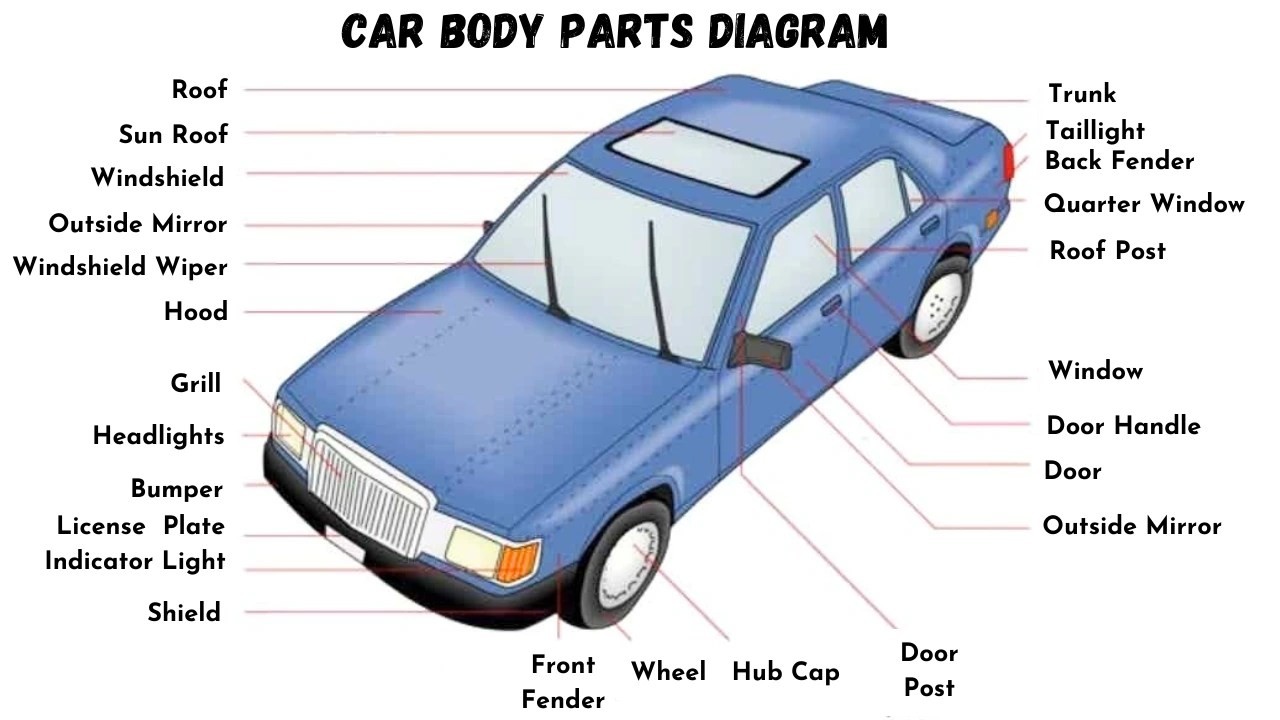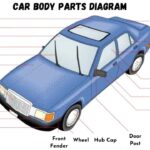Just like the face is the most recognizable part of a human, the front part of your car is its most distinctive feature, often defining its style and brand identity. But beyond aesthetics, the front part of a car is a complex assembly of crucial components working together to ensure safety, performance, and efficiency. Understanding these “facial features” of your vehicle is not just for car enthusiasts; it’s beneficial for every driver. Let’s dive into the anatomy of the front part of a car, exploring its key components and their vital roles.
Key Components of the Car’s Front End
The Front Part Of Car is more than just a pretty face. It’s a carefully engineered zone packed with parts designed for protection, illumination, cooling, and even aerodynamics. Here’s a breakdown of the essential elements:
1. Hood or Bonnet
The hood, also known as the bonnet in some regions, is the hinged cover that shields the engine compartment. It’s a primary element of the front part of car, providing both protection and accessibility.
- Protection: The hood safeguards the engine and related components from the elements – rain, snow, debris, and extreme temperatures. It also offers a degree of protection in the event of a frontal impact.
- Accessibility: Crucially, the hood allows easy access to the engine for routine maintenance, fluid checks, and repairs.
- Materials and Construction: Typically crafted from steel or aluminum for strength and lightness, modern hoods may also incorporate materials like carbon fiber or fiberglass, especially in performance vehicles, to further reduce weight.
- Design Features: Hoods can feature scoops or power bulges. These aren’t just cosmetic; they can be functional, directing airflow to the engine for cooling or accommodating larger engine components.
2. Front Bumper
The front bumper is a vital safety component located at the very front of the car. It’s designed to absorb impact during low-speed collisions, minimizing damage to the vehicle’s structure and, most importantly, protecting occupants.
- Impact Absorption: Bumpers are engineered to crumple or deform in a controlled manner upon impact. This energy absorption reduces the force transmitted to the car’s chassis and passengers.
- Material and Design: Modern bumpers are often made from plastic or composite materials over a reinforcing bar, designed for both energy absorption and pedestrian safety. They are integrated into the overall front part of car design, often blending seamlessly with the vehicle’s lines.
- Integrated Features: Front bumpers frequently house other essential elements like fog lights, parking sensors, and even aerodynamic aids.
3. Grille
Positioned prominently between the headlights, the grille is both a functional and stylistic element of the front part of car.
- Engine Cooling: The primary function of the grille is to allow airflow to the radiator and engine bay, crucial for cooling the engine and preventing overheating. Air passes through the grille as the car moves, facilitating heat dissipation.
- Brand Identity: Grilles are a significant design element and often instantly recognizable, serving as a key brand identifier. Think of BMW’s kidney grilles, for example.
- Types of Grilles: Different types exist, including main grilles, lower grilles, and fog light grilles. Their design varies greatly in mesh patterns, shapes, and sizes, contributing significantly to the car’s overall aesthetic appeal.
4. Headlights
Headlights are essential for safe driving, especially during nighttime or in low-visibility conditions. They are a critical part of the front part of car, providing illumination and signaling.
- Illumination: Headlights illuminate the road ahead, allowing the driver to see obstacles, road markings, and other vehicles.
- Visibility: They also make the vehicle visible to other road users, enhancing safety in all conditions.
- Types of Headlights: Technology has advanced significantly, moving from traditional halogen bulbs to more efficient and brighter LED and Xenon headlights. Adaptive headlights, which turn with the steering, further improve visibility in corners.
- Design Integration: Headlight design is now a major styling element, with intricate shapes and LED daytime running lights contributing to the distinctive look of the front part of car.
5. Fog Lamps
Fog lamps are supplementary lights, usually mounted lower than the headlights in the front part of car. They are designed to improve visibility in fog, mist, heavy rain, or dust.
- Enhanced Visibility in Poor Conditions: Fog lamps produce a wide, low beam that cuts through fog and illuminates the road surface below the fog layer, where headlights might be reflected back by the fog.
- Strategic Positioning: Their lower mounting position is key, reducing glare and improving forward visibility in adverse weather.
6. Indicator Lights (Signal Lights or Turn Signals)
Indicator lights, also known as signal lights or turn signals, are crucial for communicating the driver’s intentions to other road users. Located at the front and rear of the car, they are integral to the front part of car and the vehicle’s safety system.
- Communication and Safety: These blinking lights signal intended turns or lane changes, preventing accidents and promoting smooth traffic flow.
- Emergency Lights (Hazard Lights): Indicator lights also function as emergency lights, activated to warn other drivers of hazards or a breakdown situation.
7. Fenders
Fenders, also known as wings in some regions, are the body panels that frame the wheel arches in the front part of car.
- Protection from Road Debris: Fenders primarily prevent mud, stones, water, and other road spray from being thrown up by the tires and hitting the car body or other vehicles.
- Aerodynamics: They also play a role in aerodynamics, channeling airflow around the wheels and reducing drag.
- Styling Element: Fenders contribute to the car’s overall shape and styling, often featuring flared designs for a more muscular look.
8. Front Panels
Front panels are general terms that can encompass several components in the front part of car, including the bumper, grille, headlight assembly, and fenders. They essentially form the outer skin of the front end.
- Structural and Aesthetic Role: Front panels provide structural support and contribute significantly to the vehicle’s visual appeal. They are designed to fit together seamlessly, creating a cohesive and aerodynamic front part of car.
9. Windshield Wipers
While not strictly part of the “body,” the windshield wiper system is crucial for maintaining visibility through the windshield, which is a significant part of the front part of car‘s forward-facing aspect.
- Maintaining Clear Vision: Wipers clear rain, snow, and debris from the windshield, ensuring the driver’s unobstructed view of the road.
- Components: The system includes wiper blades, arms, linkages, a motor, and a washer fluid reservoir and pump, all working in concert to keep the windshield clean.
The Importance of the Front Part of Your Car
The front part of car is not just about aesthetics; it’s a critical safety and performance zone. It protects vital engine components, ensures visibility through lighting systems, and provides crucial impact absorption in collisions. Understanding the function of each component in the front part of car helps drivers appreciate the engineering and design that goes into modern vehicles and highlights the importance of maintaining these parts for optimal safety and vehicle performance. Regular checks and prompt repairs of any damage to the front part of car are essential for every car owner, ensuring both the longevity of the vehicle and the safety of everyone on the road.

